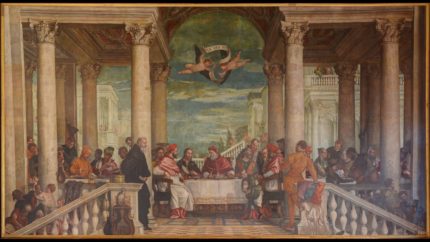A new conservation of “The Feast of Saint Gregory the Great,” a monumental painting by old master Paolo Veronese that was literally chopped up into bits, is to begin this month. The painting is 14’7″ x 28’10” and covers 420 square feet in area. Cut into 32 pieces by Austrian troops during the 1848 First Italian War of Independence, it has been restored three times in the past, but the last time was in 1973 and it is in urgent need of intervention.
One of a series of massive canvases Veronese created depicting a dinner scene, it still hangs in the space for which it was commissioned in 1572: the refectory of the monastery of the Madonna of Monte Berico in Vicenza. It depicts Pope Gregory I (r. 590-604) dining with the poor, indigent and, on his right side, Jesus Christ. Giving alms and feeding the people of Rome (many of them destitute refugees of Lombard invasions) was the primary focus of Gregory’s papacy. Legend has it that he refused to eat until every poor person in Rome had eaten, and when that goal was achieved he would invite 12 of the indigent to join him for a dinner at his family dinner table. He was from a patrician family and reached the heights of a civic career in Rome before becoming a Benedictine monk, so I’m sure it was a fine table, but not quite as large as in Veronese’s vision, or as glamorously located.
Restorers from the regional superintendence will first take down the painting in order to thoroughly analyze it with a particular focus on reconstructing Veronese’s materials and painting process. A 2017 examine found a thick coating of discoloured varnish and dirt marring the surface of the painting. Before that can be address, the conservation team will create a roadmap using non-invasive analytical techniques.
X-ray fluorescence and gas chromatography will further help conservators understand the chemical composition of the pigments, binding agent and “mestica” (primer), used by the artist.
A key challenge will be distinguishing between Veronese’s hand and the work of the painting’s past restorers: Antonio Florian in 1817, Andrea Tagliapietra in 1858 (financed by the Austrian emperor Franz Joseph I, by way of compensation for his troops’ vandalism) and Antonio Lazzarin in 1973. “My aim is to pinpoint who did what, to decide whether to remove it or leave it be,” [lead conservator Valentina] Piovan says.
The guiding philosophy, however, will be for a “minimum of intervention”, she says. Nineteenth-century repairs made with oil-based pigments are not only difficult to reverse with modern water-based solvents, but can now be considered “a coherent part of the work” in their own right.
The delicate final phase of the project will involve retouching in such a way as to “imitate the granular texture of the painting”, Piovan says. “If it’s [too] smooth, you will see all the lines of the cuts in the light.”
Conservators will work on the canvas in situ for two years. So as not to disappoint the three million annual visitors to the monastery, the refectory will remain open to the public The conservation is scheduled to end in 2021.

To the benefit of the Austrian troops and their pieces :no:
——————–
You have: 14ft+7inch
You want: meter
14ft+7inch = 4.445 meter
——————–
You have: 28ft+10inch
You want: meter
28ft+10inch = 8.7884 meter
——————–
You have: 1.09855 m * 1.11125 m * 32
You want: ft^2
1.09855 m * 1.11125 m * 32 = 420.48611 ft^2
——————–
IMPORTANT: In contrast to a ‘ft’ of 30.48 cm, the ‘Viennese ft’ had been a full 31.61023 cm. Thus, there is less ‘Viennesesquarefeet’:
——————–
You have: 1.09855 m * 1.11125 m * 32
You want: vienna_ft^2
1.09855 m * 1.11125 m * 32 = 390.95455 vienna_ft^2
——————–
A monkey and two dogs.
Is that a kitty at Jesus’ feet?